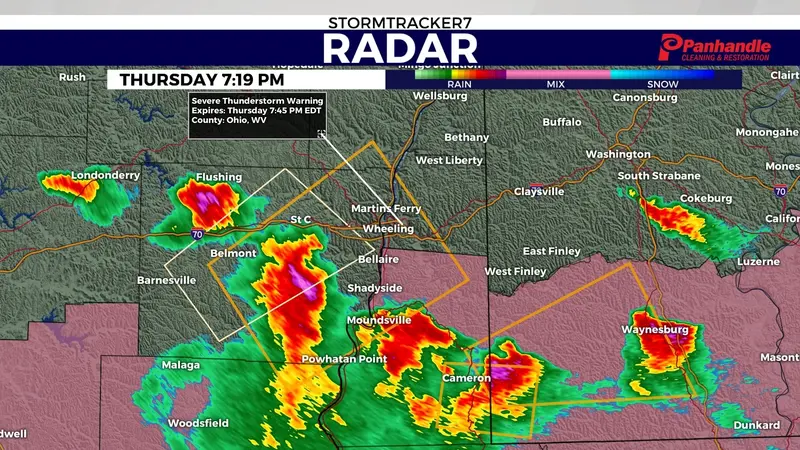When a severe thunderstorm warning near me is issued, it signals imminent danger. Severe thunderstorms can bring high winds, large hail, and even tornadoes, making it essential to act quickly. In this article, we’ll explain what a severe thunderstorm warning means, how to stay informed, and what actions you should take to stay safe.
What Is a Severe Thunderstorm Warning Near Me?
It is an alert issued when a storm is occurring or is about to occur in your area. Meteorologists issue this warning if the storm has the potential to produce dangerous conditions, including:
- Wind speeds of 58 mph (93 km/h) or higher
- Hailstones larger than 1 inch (2.5 cm)
- Tornadoes or potential tornado development
- Heavy rainfall leading to flash flooding
Unlike a watch, which means conditions are right for a storm, a warning means a severe thunderstorm is active and requires immediate attention.
Recognizing the Signs of an Approaching Severe Thunderstorm
Before a severe thunderstorm warning is issued, you may notice several signs that indicate severe weather is coming:
- Darkening Skies: The sky may turn dark, gray, or greenish as the storm approaches.
- Towering Clouds: Cumulonimbus clouds, often associated with thunderstorms, will start to form.
- Increasing Winds: You’ll feel gusty winds picking up intensity.
- Thunder and Lightning: Thunder may become louder, and lightning may increase, signaling the storm’s proximity.
By paying attention to these signs, you can stay alert and prepare for a severe thunderstorm warning near you.
How to Stay Informed About Severe Thunderstorm Warnings
Staying informed is crucial when a severe thunderstorm warning near me is issued. Here are the best ways to keep track of weather updates:
1. Weather Apps and Notifications
Weather apps provide real-time updates and can send notifications when a severe thunderstorm warning near me is active. Some reliable apps include:
- The Weather Channel
- AccuWeather
- NOAA Weather Radar Live
By customizing your settings, you can receive instant alerts for severe thunderstorms in your area.
2. NOAA Weather Radio
NOAA Weather Radio broadcasts essential weather alerts 24/7. It’s an invaluable tool for staying informed about severe weather, even during power outages.
3. Wireless Emergency Alerts (WEA)
Wireless emergency alerts are sent directly to your mobile device. These messages provide updates on severe thunderstorm warnings and other emergencies in your area.
4. Local News and Social Media
Local news stations and social media pages provide continuous updates on severe weather. Always tune in to get the latest information on a severe thunderstorm warning near me.
Steps to Take When a Severe Thunderstorm Warning Near Me Is Issued
When you receive a severe thunderstorm warning near me, it’s important to take quick action to protect yourself. Here’s what to do:
1. Seek Shelter Immediately
Go indoors as soon as you hear about the warning. Avoid staying under trees or near open fields. A sturdy building or storm shelter is the safest place.
2. Stay Away from Windows and Doors
Glass can shatter from high winds and hail. Move to an interior room or basement away from windows, doors, and skylights.
3. Unplug Electronics
To protect your electronics from potential lightning strikes and power surges, unplug sensitive devices like computers, TVs, and microwaves.
4. Monitor the Situation
Stay tuned to weather updates through radio, TV, or a weather app. Track the storm’s movement and be prepared to take additional safety measures.
Preparing for a Severe Thunderstorm Warning Near Me
Preparation is key when it comes to dealing with severe thunderstorms. Here’s how to prepare for a severe thunderstorm warning:
1. Create an Emergency Kit
Having an emergency kit on hand will ensure you have essential items during the storm. Include:
- Bottled water and non-perishable food
- A flashlight and extra batteries
- First-aid supplies
- A battery-powered radio
- Important documents in waterproof bags
2. Secure Your Home
Take the time to secure your home before severe weather strikes. This includes:
- Trimming overhanging tree branches that could fall in high winds
- Reinforcing windows with storm shutters or plywood
- Bringing in outdoor furniture and decorations that could become projectiles
3. Develop a Family Emergency Plan
Ensure your family knows what to do during a severe thunderstorm warning near me. Designate a safe room, plan evacuation routes, and set up a communication plan in case of separation.
What to Do After a Severe Thunderstorm Warning Near Me
After the storm passes, there are still safety steps to follow:
1. Assess the Damage
Inspect your home and surroundings for damage. Be cautious of downed power lines, fallen trees, or areas with standing water. Avoid contact with these hazards.
2. Report Hazards
Report any dangerous conditions, such as downed trees or power outages, to local authorities or utility companies. This helps speed up recovery efforts.
3. Stay Informed
Continue to monitor local weather updates. Sometimes, a storm can reignite or cause new hazards, such as flash floods or additional severe weather.
Why Severe Thunderstorms Are Becoming More Common
Climate change has been linked to more frequent and intense severe thunderstorms. Rising temperatures contribute to stronger storms, with more moisture in the air, making severe weather events like this more likely. Understanding these patterns helps us better prepare for future storms.
Final Thoughts
When a severe thunderstorm warning near me is issued, it’s crucial to act quickly and wisely. By staying informed, preparing your home and family, and taking immediate action, you can protect yourself and minimize damage. Severe thunderstorms are dangerous, but with the right precautions, you can weather the storm safely.
If you enjoyed this article and would like to read more like it, please check out the rest of our blog today.
